Dearborn, MI - Ford Super Duty customers rely on their trucks to get the job done – whether at work or at play. The 2005 Super Duty delivers – with more capability, unsurpassed gas and diesel power, more toughness and useful new features that will make work easier and recreation time more enjoyable.
“The original Super Duty proved that pickup trucks with the right stuff could handle jobs that once were associated only with the big, commercial medium-duty truck segment,” said Frank Davis, Ford vehicle programs director for pickups and commercial vehicles. “The 2005 Super Duty takes this capability to the max, with towing and cargo ratings that will astound our customers.”
The 2005 Super Duty features a host of functional, capability and convenience improvements:
- Increased tow ratings across the board, with best-in-class maximum tow rating of 17,000 pounds.
- Class-leading payload for Super Duty pickups – up to 5,800 pounds of cargo in the F-350 dually. On average, payload improves 500 to 1,000 pounds for F-250 and F-350 pickups.
- TowCommand™ System – a combination of standard and optional features that makes towing easier, including an industry-first factory-installed trailer brake controller.
- Unsurpassed power – including the segment’s most powerful gasoline engine, the 6.8-liter, 3-valve Triton™ V-10 with 355 hp and 455 pound-feet of torque. The best-selling 6.0-liter Power Stroke® diesel increases to 570 pound-feet of torque.
- A new front suspension and improved steering for better ride, handling and maneuverability in 4X4 pickups and all F-450 and F-550 chassis cabs.
- Best-in-class braking, with larger rotors and larger, stiffer calipers. Even the parking brake is larger and stronger.
- Stronger, tougher frame underlying all of this new capability.
- Design changes that cap off the new capabilities with a bolder, tougher look up front, the segment’s only 18- and 20-inch wheels and a more refined interior.
Higher Tow Rating, More Payload Capacity
For 2005, Ford Super Duty pickups have more towing and payload capacity than ever, making F-350 the clear class leader, for towing up to 17,000 pounds.
All Super Duty trucks – from F-250 through F-550 – benefit from chassis upgrades, including stronger frames and available stronger axles.
Ford responded to marketplace changes by implementing a new variable gross vehicle weight rating strategy across all of its Super Duty F-Series pickups that better accommodates the way most customers use their trucks.
With more customers opting for features like diesel engines, four-wheel-drive and crew cabs, this new strategy takes advantage of the Ford Super Duty's higher axle weight ratings, stronger frames and better brakes to help preserve payload capability on trucks with higher equipment levels.
As a result, maximum pickup payload capacity increases by up to 1,280 pounds.
Towing follows suit. With the 5.4-liter, 3-valve Triton V-8 engine, Super Duty now can tow up to 12,300 pounds, an increase of 3,000 pounds, making this economical powertrain even more attractive for fleet and commercial users.
Dual-rear-wheel Super Duty pickups with the 6.8-liter, 3-valve Triton V-10 and 6.0-liter Power Stroke diesel will have the ability to tow up to a class-leading 15,000 pounds conventionally. That’s an increase of up to 1,600 pounds and establishes Super Duty as the clear leader in the class.
“There’s a reason people look up to Super Duty as the benchmark in this class,” said Susan Dehne, F-Series Super Duty chief engineer. “It was a great truck to begin with – and we’ve improved more than 100 individual areas to make it even better.”
The F-250/F-350 Super Duty frame features a new fully boxed front section, improving strength and torsional stiffness.
From the boxed section back, the frame uses steel that is 10-percent to 17-percent thicker, with additional gussets providing even more strength and durability in high-stress areas. This is the thickest gauge steel in any pickup.
This strong new frame extends back to an optional new 2.5-inch hitch receiver. This is an increase from the previous 2-inch receiver, and allows the higher conventional tow rating.
TowCommand™ System Makes Towing Easier
The 2005 Ford Super Duty offers a package of standard and optional features specifically geared toward users who tow trailers. Since a trailer behind a Super Duty tends toward the bigger, heavier and bulkier end of the scale, towing brings more demands. The TowCommand System is intended to make life easier for the driver when a big load is along for the ride.
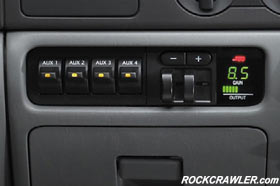 “This truck is all about capability and control,” said Dehne. “Knowing 90 percent of our customers tow trailers, towing had to be a priority in our improvements.”
“This truck is all about capability and control,” said Dehne. “Knowing 90 percent of our customers tow trailers, towing had to be a priority in our improvements.”
The TowCommand System, which includes the industry’s first factory-installed and warranted electronic trailer brake controller, offers smoother operation and safety features.
This includes a special trailer brake strategy when the truck’s anti-lock braking system detects poor traction. No aftermarket trailer brake controller can do this.
The electronic trailer brake controller is integrated into the instrument panel, with graphics that match the rest of the Super Duty interior. It gives audible and visual warnings if trailer wiring becomes disconnected.
Ford’s TowCommand System also includes TorqShift® transmission with tow-haul mode, best-in-class brakes and telescoping trailer tow mirrors.
Class-Leading Power
The 2005 Ford Super Duty offers an unequaled lineup of powertrain options, including the segment’s most powerful gasoline engine. Ford’s three-valve-per-cylinder head, introduced on the 2004 F-150, is now available for the first time on a V-10 engine, thanks to Ford’s modular engine strategy.
The new 6.8-liter, 3-valve Triton V-10 produces 355 horsepower and 455 pound-feet of torque – both class-leading figures.
The segment’s best-selling diesel engine – Power Stroke – benefits from 10 more pound-feet of torque. The 6.0-liter Power Stroke diesel is now rated at 570 pound-feet of torque and 325 horsepower.
Ford’s modular 5.4-liter, 3-valve Triton V-8 also migrates to Super Duty. Its three-valve architecture and sophisticated technology, including variable valve timing, help to deliver 300 horsepower and 365 pound-feet of torque. That’s an improvement of 40 horsepower and 10 pound-feet of torque over the 2004 Super Duty. More than 80 percent of peak torque – nearly 300 pound-feet – is available starting as low as 1,000 rpm.
Both gasoline engines also now benefit from electronic throttle control, which provides economy and performance benefits. For commercial users who need to elevate engine speed to run aftermarket power takeoff (PTO) systems, the new “stationary elevated idle control” feature is now included in the strategy of all Super Duty powertrains.
This replaces the auxiliary idle control kit and auxiliary powertrain control module that was optional in the 2004 model year. This feature and the new segment-first dash-mounted upfitter switches are the direct result of Ford’s dialogue with its commercial users.
Better Ride, Handling
Super Duty’s strong new frame also helps to enable better ride and handling, in concert with other improvements to the 2005 model.
A new monobeam coil spring front suspension replaces the leaf springs on four-wheel-drive F-250 and F-350 pickups. Efficient packaging of the new front suspension allows the front wheels to turn 18 percent further. This dramatically improves maneuverability and reduces the average turning circle by more than 5.5 feet.
Changes to the steering geometry, tighter internal tolerances in the new steering gear and a revised power assist curve improve steering feel.
The F-450 and F-550 Super Duty trucks get more than a 12-foot improvement in average turning diameter. “That is a huge benefit for commercial users who are maneuvering in a tight space to reach a job site,” Dehne said.
The rear suspension has new spring rates and staggered rear shock geometry to improve ride quality.
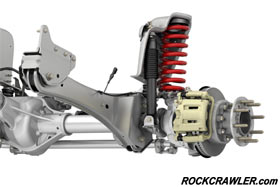 Stronger Brakes
Stronger Brakes
New, larger wheel sizes on F-250 and F-350 – 17 inches as the standard wheel, with 18 inches on some models and a segment-first 20 inches on the Ford Harley-Davidson™ F-Series Super Duty – allowed engineers to upsize brake rotors by 5 percent, to 347 mm in front and 340 mm in rear. This provides greater braking surface and helps to dissipate heat, especially on long downhill roads.
Other improvements include larger calipers for both the F-250 and F-350. The front calipers have twin 60 mm pistons – up 11 percent from 2004 – for better braking feel. Rear calipers have twin 48 mm calipers on F-250 and twin 54 mm pistons on F-350 dual-rear-wheel models. The F-450 and F-550 also benefit from 30-percent stiffer calipers and larger brake rotors. New brake pad material provides quieter stops while more than doubling the lining life.
Design is Tougher, More Sophisticated
Super Duty’s new look reflects the changes under the skin with a bolder front profile and new wheel designs that communicate strength. Inside, the message is sophistication and refinement, with a new gauge cluster and instrument panel treatment.
The bold front grille – always a Super Duty signature – is even bolder for 2005, drawing cues from the popular Mighty F-350 TONKA concept truck’s chiseled good looks. Sharper edges and vertical bar surfaces provide a milled appearance.
A new exterior two-tone treatment includes a lowered “waterline” and new color combinations. Wheel lip moldings coordinate with the two-tone treatment on some series.
Larger three-dimensional badges identify each series and powertrain.
The 2005 Ford Harley-Davidson™ Super Duty now offers an industry-first “flame” paint option, with choice of black-and-red or blue-on-blue.
The flames, designed by a Harley-Davidson factory customizer, are painted using Ford’s patented wet-on-wet process, which produces a durable, seamless finish in the factory.
On the interior, new trim panels surround the central and driver’s side portions of the instrument panel, and match the inserts on the doors. These changes help reinforce differentiation among the series:
- King Ranch trucks sport a new straight-grained Dark Mandarin Teak wood-appearance applique, complementing the distinctive Castaño leather used on seats, steering wheel and other trim. Unique badges inside and out identify the King Ranch Ford Super Duty.
- Lariat trucks feature a warmer horizontal Cherry Zebrano grain wood appearance on interior trim, along with a host of interior comfort and convenience features, including leather-trimmed seating surfaces with six-way power driver’s and front Crew Cab passenger seat, as well as audio and climate controls on the steering wheel spokes.
- XLT Sport trucks use a pewter wave finish on interior applique panels, for a strong, machined appearance.
- Dark accent charcoal black is used in XLT trucks.
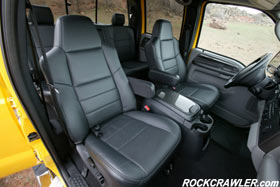 XLT Interior
XLT Interior |
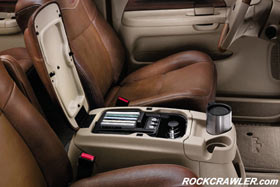 King Ranch Interior
King Ranch Interior |
A new gauge cluster is cleaner and easier to read, with the circular speed and tachometer gauges flanking the message center, when equipped, and gear selector display. Modular design allows more differentiation in the gauge package, as well.
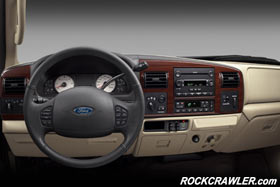 XLT Interior
XLT Interior |
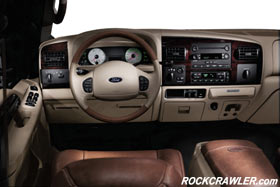 King Ranch Interior
King Ranch Interior |
The climate control vents are now barrel-shaped and integrated into the surrounding surfaces no matter where they are pointed. That follows the pattern set by the optional new integrated electronic trailer brake controller and upfitter switches. The result is a clean, uncluttered interior.
Generous Space, Storage
Super Duty continues to lead the class in interior space. Various front seats are available, including a 40/20/40 split bench that offers a fold-down center arm rest with storage bin and two cup holders.
Rear seats offer convenient interior cargo options. The available Crew Cab Flex Fold™ rear bench seat, introduced in the 2004 model year, allows the user to fold down one or both seatbacks to create a flat shelf, or fold the seat bottoms up and fold out a flat steel load floor. The rear doors of Crew Cab models to swing open 76 degrees, for better access to the rear seating area.
F-Series Super Duty
Ford’s Super Duty lineup includes F-250 and F-350 pickups, as well as F-350, F-450 and F-550 chassis cabs, and is a part of Ford’s F-Series truck family – America’s best-selling truck for the past 27 years, and the best-selling vehilce, car or truck, for the past 22 years.
The 2005 Ford F-Series Super Duty will be built at Ford’s Kentucky Truck Plant in Louisville, Ky., and will arrive in dealerships this fall.
POWERTRAIN
The 2005 Ford Super Duty offers an unequaled lineup of powertrain options, including the segment’s most powerful gasoline engine, backed by chassis and frame improvements that make the strongest pickup on the road even stronger. Together, they deliver the highest available payload ratings in the industry.
The most respected name in truck diesel engines, with more than 3 million on the road – Power Stroke – also benefits from upgrades for 2005, with 10 more pound-feet of torque from the quiet 6.0-liter V-8 diesel, and the widest power band in the market.
Ford’s strong and sophisticated five-speed TorqShift automatic transmission, previously available only with the Power Stroke diesel, now will be offered with all Super Duty engines, gas and diesel.
The powertrain lineup for 2005 includes:
6.8-liter Triton V-10 – for the first time, Ford’s aluminum 3-valve cylinder head, introduced on the 2004 F-150, is available on a V-10 engine. The new 6.8-liter, 3-valve Triton V-10 is the most powerful gasoline engine in the class, with 355 horsepower and 455 pound-feet of torque – both class-leading figures. Like all of the Super Duty engines, it uses electronic throttle control for efficiency and quick response.
5.4-liter, 3-valve Triton V-8 – Super Duty’s “base” engine also benefits from three-valve architecture and sophisticated technology, including variable valve timing and electronic throttle control, to deliver 300 horsepower and an unrivaled combination of performance and economy, which is particularly important for fleet users.
6.0-liter Power Stroke diesel – Ford set a new standard with the original 7.3-liter Power Stroke in 1994, then did it again with the 6.0-liter Power Stroke in 2003. For 2005, the Power Stroke gets 10 more pound-feet of pulling power.
TorqShift – Ford’s premium heavy-duty automatic transmission is now offered with every Super Duty engine, offering the smoothest, crispest shifts in the class, the exclusive computer-controlled tow-haul mode, plus the economy and performance benefits of five speeds, compared with competitors’ four.
Segment Leading 6.8-liter, 3-valve Triton V-10
Ford’s proven modular engine strategy pays dividends yet again by bringing the company’s acclaimed three-valve architecture – introduced on the F-150’s 5.4-liter Triton V-8 engine – to the 6.8-liter Triton V-10 gasoline engine available in the 2005 Super Duty.
The result is a 45-horsepower boost in peak power – to 355 hp at 4,750 rpm – with improved smoothness, reduced emissions and no significant fuel economy penalty during normal use. Peak torque rises from 425 to 455 pound-feet at 3,250 rpm.
The Super Duty powertrain engineers assured the broadest, flattest power band in the segment by equipping the 6.8-liter Triton V-10 with variable intake runners. This means that power is available in every gear, at every speed – for pulling a heavy boat up a ramp or for passing a truck on a two-lane road.
“At lower RPM, the engine uses the long intake runners to generate maximum torque,” said Harold Lowman, Commercial Vehicles powertrain manager. “At higher engine speeds, the intake shifts to the shorter runners. This gives you a very flat torque curve and good response across the rev range.”
The new cylinder head incorporates three valves per cylinder – two intake and one exhaust – for better engine breathing and better fuel-air mixing prior to combustion. This means the engine is able to provide all the fuel and air needed to meet higher peak demands, such as when hauling a heavy load uphill.
At the same time, the powertrain controller automatically varies spark timing to optimize combustion. With the spark plug now located precisely in the center of the combustion chamber, the engine operates at maximum efficiency, producing more power than before while still using regular octane gasoline.
Modern Electronic Throttle Control
Both gasoline engines also use electronic throttle control, which gives Super Duty powertrain engineers far more ability to assure engine performance matches the driver’s intent. When the driver calls for maximum acceleration, the throttle plate opens at the optimum speed to match fuel flow, cam timing and other engine parameters with gear selection of the five-speed TorqShift automatic transmission.
Another benefit of electronic throttle control is a new elevated idle function standard on all vehicles, which allows elevated idle control for aftermarket accessories such as hydraulic pumps for tow trucks or dump beds. This feature raises the idle speed to provide the necessary power to run these applications, without a complicated manual throttle linkage. The optional transmission mounted Power Takeoff (PTO) continues to be available.
Power Plus Economy – 5.4-liter, 3-valve Triton V-8
The 5.4-liter, 3-valve Triton V-8 engine introduced last year on the Ford F-150 now migrates to Super Duty. It brings 300 horsepower and 365 pound-feet of torque to the table, giving gas-engine customers two strong choices – maximum power with the V-10, or power plus economy in a V-8 package.
That’s an improvement of 40 horsepower and 15 pound-feet of torque over the 2004 Super Duty, thanks in part to the use of variable valve timing that especially boosts low-end torque, which has always been a strength of the 5.4-liter Triton engine. Now, more than 80 percent of peak torque is available starting as low as 1,000 rpm.
A large amount of torque is especially valuable in pulling a heavy load from a standstill.
With variable valve timing, the computerized powertrain control module automatically adjusts timing of the single-overhead camshafts to optimize intake and exhaust valve actuation at any engine speed. By varying pressure inside the hydraulic solenoids at the camshaft sprockets, the system can shift between fully advanced cam timing and fully retarded timing in milliseconds.
Variable valve timing offers several benefits in addition to the added torque. It reduces internal pumping losses, making the engine more efficient. By allowing part of the exhaust gases to re-enter the cylinder at higher engine speeds, it reduces temperatures within the combustion chamber, for cooler running, and reduces production of the pollutant NOx. Both Super Duty gasoline engines are expected to meet more stringent emissions standards.
Both gasoline engines also feature the so-called “limp home” mode, which selectively cuts power to individual cylinders in the event of complete coolant loss, to control engine temperatures and allow the vehicle to move a short distance for repairs.
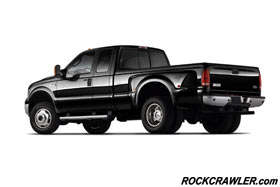 A More Powerful Power Stroke Diesel
A More Powerful Power Stroke Diesel
Revised mapping of the electronic engine control system brings even more torque to the strong, quiet 6.0-liter Power Stroke diesel engine. With 570 pound-feet of torque and 325 horsepower, the 6.0-liter Power Stroke offers more torque and is now rated for an even longer service life – 250,000 miles, with proper maintenance.
The 6.0-liter Power Stroke diesel engine uses modern technologies such as the high-pressure fuel rail, which delivers fuel to the individual direct-injectors at pressures of up to 26,000 pounds per square inch (1,800 Bars). This allows precise metering and complete atomization of the fuel mixture, for clean burning.
With four valves per cylinder, the 6.0-liter Power Stroke is able to move large volumes of air and fuel at peak load.
Other modern technologies in the Power Stroke include electronic throttle control and an Electronic Variable Response Turbocharger with variable vanes that tailor boost to demand, allowing the turbocharger to “spool up” faster under peak demand to reduce “turbo lag,” and offer better efficiency than fixed turbo vanes.
Two out of every three Super Duty trucks sold are equipped with Power Stroke diesel engines. Ford sells more diesel-powered pickup trucks than Dodge and General Motors combined – more than 200,000 per year in Super Duty alone. Super Duty’s Power Stroke is the longest lasting diesel available, with more than 98 percent of Power Stroke diesel engines produced over the past decade still on the road.
“Customers buy the Power Stroke diesel knowing that it’s there for the long haul,” said Doug Scott, Ford Truck Group marketing manager. “At 100,000 miles, they expect that it’s just getting broken in.”
TorqShift Five-Speed Automatic Transmission
Ford’s modern five-speed TorqShift automatic transmission – first offered on 2003 Super Duty trucks equipped with the 6.0-liter Power Stroke diesel engine – becomes available with all Super Duty powertrains for 2005.
The TorqShift transmission features improved gear ratios, higher capacity pumps for better cooling, robust components for durability and simplified shift controls for smoother shifts and quieter operation, compared with the previous four-speed automatic.
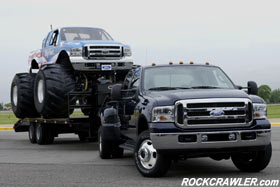 Tow-Haul Mode
Tow-Haul Mode
Those who tow or haul heavy loads will appreciate the tow-haul mode, which automatically adjusts transmission operation to reduce unnecessary shifts and keep the engine in the power band when needed. It can sense, for example, when the vehicle is driving over hilly terrain, and hold the current gear longer, to reduce “hunting” for the proper gear.
The transmission also works in concert with the engine in downhill sections of roadway, to prevent the vehicle from speeding up unintentionally. This helps improve the driver’s feeling of control, while supplementing the vehicle’s braking system.
An adaptive shift function monitors the transmission’s performance over its lifetime, and adjusts shift pressures in real time to assure consistent shift feel and compensate for wear.
For ease of maintenance, the transmission oil filter is a spin-off style, mounted on the exterior of the transmission. Larger fluid lines and a larger transmission oil cooler help to assure cooler operating temperatures, even under the most demanding conditions.
Chassis Improvements Provide Strong Support
The Super Duty chassis serves as a foundation for all of this added power, and improvements for 2005 assure that it will be more than up to the task. Properly equipped, the 2005 Super Duty offers the highest payload capacity, most towing capability, highest gross vehicle weight rating and gross combined vehicle weight ratings in the class.
Maximum pickup payload reaches 5,800 pounds – an increase of 300 pounds and the highest in the class. Front axle ratings are increased by 800 pounds on F-250 and F-350 4x4 models, and 1,000 pounds on all F-450 and F-550 trucks. Maximum combined weight rating for the dual-rear-wheel F-350 – including truck, payload and trailer – is now a massive 23,500 pounds.
At the same time, chassis improvements provide better ride and handling, especially when towing or hauling. This complements improvements to the steering gear and suspension geometry.
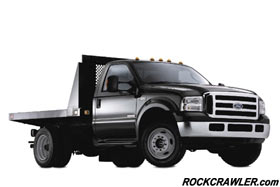 Stronger, Tougher Frame
Stronger, Tougher Frame
The front portion of the Super Duty frame, on either side of the engine, has been boxed in, for additional strength and torsional stiffness. This provides a stiffer support for the front suspension, improving handling response.
The rear portion of the frame – everything behind the fully boxed section – now uses steel that is 10-percent to 17-percent thicker. This is the thickest gauge steel used on any pickup frame.
A new rear cross member and new hitch – with 2.5-inch receiver on some models – provides more structural strength for towing or heavy hauling. The upsized hitch is recommended for towing loads over 12,500 pounds. The F-350 Super Duty can pull 15,000 pounds with the 2.5-inch hitch, and up to 17,000 pounds with a fifth-wheel or gooseneck hitch.
Thanks to modular design, these changes were achieved very efficiently. Common tooling is used for the front portion of every truck frame from the F-250 through F-550. Adding modular elements creates 18 total frame options for the truck configurations customers want – Regular Cabs to Crew Cabs, long bed or short bed, single- or dual-rear-wheel – without undue complexity.
Proven Durability
“This architecture has been proven over hundreds of millions of miles by our engineers and our customers,” said David Watts, supervisor of Ford Super Duty Frame Design and Chassis Engineering. “We’ve maintained the qualities that produced this great performance, while adding more capability.”
Among the engineering torture tests that Watts’ team conducts is driving again and again over a rugged off-road route at Ford’s Arizona Proving Ground – while the truck has 5,000 pounds of pig iron on its back.
“We look at what our toughest customers demand from their trucks, and then duplicate those conditions repeatedly, all with the truck loaded to its full rated capacity,” Watts said. “Our standard of success is zero failures – not one. Most competitors wouldn’t come close to surviving this.”
As an example of the engineering team’s attention to detail, the 2005 Super Duty now uses microcellular urethane, compression-style body mounts, which provide good isolation for the passenger compartment and offer better durability than rubber mounts.
“It’s all about strength and durability,” Watts said.